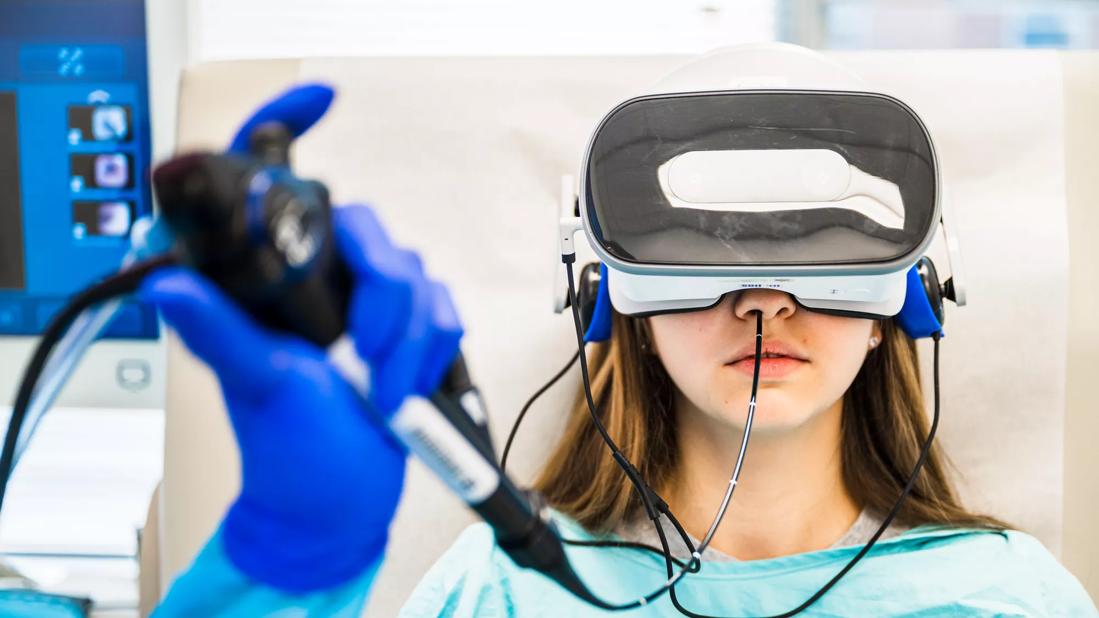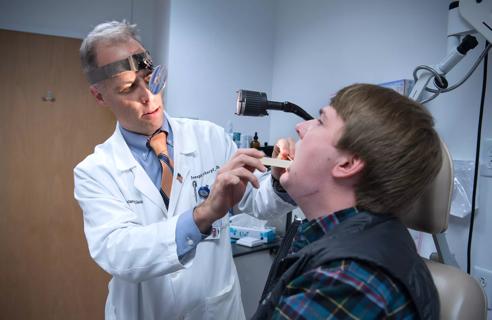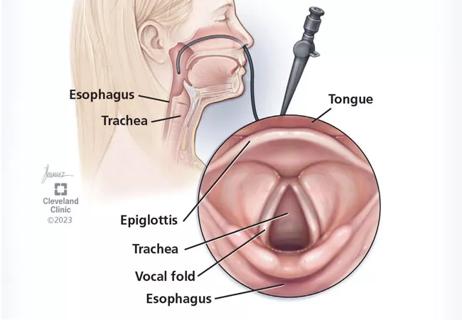A safe alternative to operative laryngoscopy

A new study, presented at the Combined Otolaryngology Spring Meetings (COSM) 2019 in Austin, Texas, finds that office-based lower airway endoscopy (OLAE) is a safe alternative to operative laryngoscopy in pediatric patients. OLAE may help patients avoid exposure to anesthesia, as well as reduce surgical costs, while providing real-time diagnoses to families.
Advertisement
Cleveland Clinic is a non-profit academic medical center. Advertising on our site helps support our mission. We do not endorse non-Cleveland Clinic products or services. Policy
When a pediatric patient presents with airway complaints, such as stridor or stertor, work up often includes in-office flexible fiberoptic laryngoscopy (FFL) to rule out pathologies. FLL provides good visualization of the upper airway; however, FLL provides visibility only above the vocal cords and may miss issues in the lower airway.
Rigid laryngoscopy and bronchoscopy under anesthesia remain the gold standard for diagnosing pathology of the lower airway among pediatric patients. Among adult patients, however, OLAE is often used to attain visualization below the vocal cords. The aim of this study was to explore the safety and feasibility of OLAE in pediatric patients to determine whether or not it might be used to help avoid exposure to general anesthesia.
“We try to reduce exposure to general anesthesia in children under three years old in order to lower the potential neurocognitive risks of anesthesia,” says Cleveland Clinic otolaryngologist and senior author on the paper, Brandon Hopkins, MD. “While not yet completely understood, age at anesthesia, length of anesthesia, and repeat anesthesia all likely play a role in terms of possible detrimental effects.”
All participants were counseled on the potential for and risks related to OLAE prior to consent. The FLL procedure generally requires caregiver assistance in holding the patient’s arms and legs while nurses hold the head still. Even an older pediatric patient capable of holding still without restraint may require someone to steady their head. FLL uses local anesthesia, in this case, 2% Lidocaine and Phenylepherine.
Advertisement
An in-office flexible fiberoptic procedure allows the otolaryngologist to evaluate the nasal cavity, nasopharynx, oropharynx, supraglottis and glottis. Then, based on symptoms and presentation, the physician decides whether or not to proceed with OLAE through the vocal cords. After the procedure, patients remain in the office for observation for 10-15 minutes.
Researchers reviewed video from 488 in-office flexible fiberoptic procedures, 77% of which revealed normal laryngoscopy, while 21.5% of them included an office-based lower airway endoscopy. Of the 105 patients who underwent OLAE, 40% had no pathologic findings. Following this group, the next most common findings from the OLAEs performed were laryngomalacia (36.2%) and inflammation (8.7%). There were no complications in any of the FLL or OLAE procedures.
Overall ease of the procedure was rated either 1 (unable to perform), 2 (some difficulty, required more than 3 attempts), or 3 (without difficulty, requiring 3 or fewer attempts). In this study, the overall ease of conducting OLAE broke down in the following ways: 45.7% received a score of 3, 29.5% received a score of 2, and 24.8% received a score of 1.
“Interestingly, previous reports indicate that OLAE can be performed without difficulty 90% of the time. Those studies also indicated that the subglottis, trachea and carnia were well visualized in 90% of cases, notes Dr. Hopkins. “In our study, we found OLAE more challenging, and described the subglottis and trachea as well visualized in only 70% of cases.”
Advertisement
Dr. Hopkins explains the diagnosis and age range of the patients in this study may account for some of this difference. Forty-eight percent of the patients in this study were less than one year old, and it can be quite difficult to keep children still at this age.
“Additionally, when we compared the ease of OLAE by diagnosis, we found that larygnomalacia cases were difficult (38.5% received a score of 2) or impossible (23.1% received a score of 2). It’s important to note,” Dr. Hopkins continues, “that, in spite of this difficulty, we had no complications during or following any of the OLAE procedures. Assuming safety precautions are taken, OLAE appears to be a means of visualizing the lower airway that is both feasible and safe in many cases.”
Laryngomalacia is a congenital abnormality in which the laryngeal cartilage is flaccid and prolapses over the larynx during inspiration, which can lead to airway obstruction. Symptoms of laryngomalacia include stridor and feeding problems. In severe cases, the child may have apnea, failure to thrive, sternal or intercostal retraction, and cyanosis. Visualization of the airway is required in order to determine the cause of stridor, dysphonia, or other airway symptoms.
Advertisement
Advertisement

New system brings much-needed clarity and guidance for moderate to advanced-stage disease classifications

Prompt, multidisciplinary care helps navigate the complexities of a rare condition

Looking at short-term outcomes in a high-risk population

Recommendations look to change mindset with CI referrals

Research aims to better understand the tumor immune micorenvironment

Research could help direct care pathways for patients with unexplained swallowing difficulties

Strong communication with the patient and a thorough approach are essential

Cleveland Clinic physicians weigh in